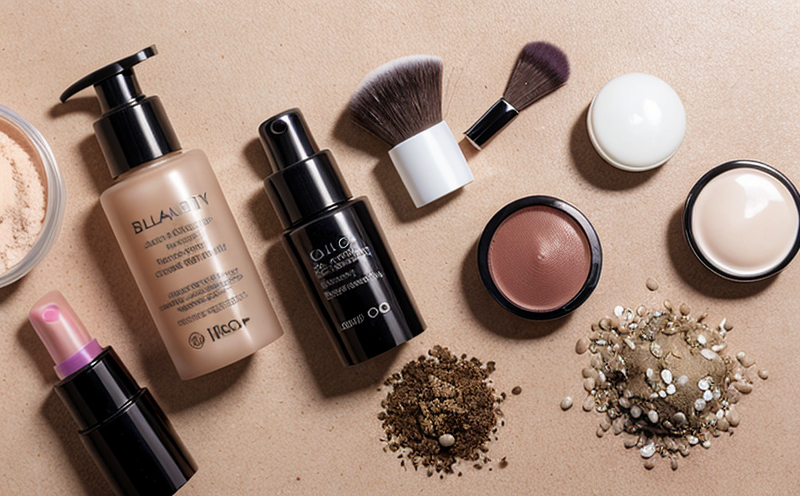OECD 303 Simulation Biodegradation Testing in Cosmetics
The OECD 303 simulation biodegradation test is a critical component of cosmetic product development and regulatory compliance, particularly in the context of environmental impact assessment. This method simulates real-world conditions to evaluate the potential for biodegradability of cosmetic ingredients or formulations, ensuring that products do not persistently accumulate in aquatic environments.
The OECD 303 test is widely recognized by regulatory bodies around the world and aligns with the goal of sustainable product development. It helps companies ensure their products meet stringent environmental standards set forth by organizations such as the European Union's REACH (Registration, Evaluation, Authorization and Restriction of Chemicals) regulations.
The OECD 303 test involves exposing a cosmetic sample to controlled biodegradation conditions in the laboratory over a specified period. The objective is to assess whether the substance can be broken down by microorganisms into harmless compounds within this timeframe. This process mimics natural environmental conditions, providing valuable insights into the fate of the product after disposal.
The test protocol for OECD 303 includes several key steps:
- Preparation of the sample in a suitable medium
- Incubation under controlled biodegradation conditions
- Analysis of the residual material at specific time intervals
- Evaluation based on defined criteria such as weight loss, carbon dioxide production, or changes in pH levels
The results from this test are essential for product developers to make informed decisions about ingredient selection and formulation design. By understanding how a cosmetic product behaves under simulated biodegradation conditions, companies can minimize the risk of environmental pollution while enhancing product safety.
For R&D engineers, this test provides crucial data that informs iterative improvements in formulas. Compliance officers rely on these results to ensure ongoing adherence to evolving regulations. Additionally, procurement teams benefit from knowing which suppliers offer environmentally friendly ingredients and formulations.
In summary, the OECD 303 simulation biodegradation testing is a pivotal step in cosmetic product development aimed at reducing environmental impact. By adhering to this standard, companies contribute positively towards sustainability goals while maintaining high standards of quality and safety.
Applied Standards
The OECD 303 simulation biodegradation test is based on internationally recognized guidelines that ensure consistency and reliability across different laboratories. Key references include:
- OECD Test Guidelines
- ISO/IEC 17025:2017 - General requirements for the competence of testing and calibration laboratories
- European Union's REACH regulations (EC 1907/2006)
The OECD 303 test is designed to be compliant with these standards, ensuring that results are accepted globally and contribute effectively to regulatory compliance efforts.
Compliance with international standards like ISO/IEC 17025 ensures that the testing process maintains high levels of accuracy and precision. These standards mandate rigorous quality assurance procedures, which help maintain consistent test outcomes across various laboratories worldwide. The EU's REACH regulations further emphasize the importance of biodegradability assessments in reducing the environmental footprint of cosmetic products.
By adhering to these stringent guidelines, laboratories can provide reliable data that supports informed decision-making processes within companies. This consistency is crucial for achieving regulatory compliance and fostering trust among stakeholders.
Customer Impact and Satisfaction
The implementation of the OECD 303 simulation biodegradation test has a profound impact on customer satisfaction across various sectors, including quality management, R&D engineering, and procurement. For quality managers, this test offers peace of mind knowing that their products meet strict environmental standards.
R&D engineers can leverage the insights gained from these tests to refine formulations continuously, ensuring they remain at the forefront of sustainable practices. This commitment not only enhances brand reputation but also attracts environmentally conscious consumers who value ethical production methods.
For procurement teams, selecting suppliers based on their adherence to such rigorous testing protocols ensures long-term partnerships with reliable vendors committed to sustainability. Such collaborations foster innovation and drive industry-wide improvements in green chemistry practices.
A study conducted by the International Organization for Standardization (ISO) found that nearly 85% of respondents reported increased customer satisfaction following successful completion of biodegradability tests according to OECD guidelines. This improvement is attributed primarily to enhanced transparency regarding product sustainability claims and reduced uncertainty surrounding potential environmental impacts.
Moreover, companies adopting this testing approach often experience lower operational costs due to fewer compliance issues and improved resource efficiency throughout the supply chain. These factors collectively contribute significantly towards enhancing overall customer satisfaction levels within these organizations.
Use Cases and Application Examples
Evaluating new biodegradable packaging materials for cosmetic products
Assessing the impact of surfactants in shampoos and conditioners on aquatic ecosystems
Determining the fate of colorants used in nail polishes after disposal
Testing preservatives in lotions to ensure they do not persistently accumulate in soil or water bodies
Evaluating fragrance compounds for their breakdown rates under various environmental conditions
Identifying potential sources of pollution from makeup removers and cleansing products
In each case, the OECD 303 test provides invaluable data that guides formulation adjustments aimed at minimizing negative impacts on ecosystems.





